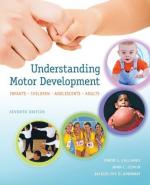|
This section contains 355 words (approx. 2 pages at 300 words per page) |
Developing motor (muscular movement) skills is an essential part of normal child development. Muscles are controlled by the brain, which learns through experience how to send proper signals to muscles controlling such motor activities as walking, balancing, throwing, and writing. Even the simplest of motor skills may be far more complex than is readily apparent. For example, no fewer than 200 opposing muscles must co-ordinate just to allow an infant to stand.
In a newborn child, the first movements are random, involving the larger muscles. Through developmental experiences, the child progresses to intentional motions: grasping objects with the hands, rolling over, standing, walking, and then to complex activities such as catching a ball, which requires carefully co-ordinated use of the eyes and hands.
Gross motor skills are those that involve large muscles. Fine motor skills use the smaller muscles (such as those in the fingers) in conjunction with the eyes.
Some typical motor development milestones follow:
- Smiling, 1 month
- Rolling over, 5 months
- Sitting, 7 months
- Crawling, 8 months
- Creeping, 10 months
- Standing, 11 months
- Walking, 13 months
- Talking (words), 10 months
- Talking (sentences), 21 months
When considering the above list of development milestones, it is important to remember that all children learn at their own pace. Many perfectly normal children will progress faster or slower than their colleagues. For instance, the typical range for walking is between eight and 18 months, and for talking (words) is from six to 14 months.
Parents may encourage gross motor development by providing indoor and outdoor play environments that promote motor skills. These may include balls, swings, slides, jungle gyms, or an improvised obstacle course. Such equipment should be checked regularly to make sure it is safe. Watch for loose nuts or bolts, splinters, sharp edges, and other hazards. Fine motor skills may be encouraged by providing pegboards, shape sorters, building blocks, popbeads, ring stackers, puzzles, crayons, chalk, paint, and craft supplies.
When selecting age-appropriate motor activities for a child, it is important to choose those that encourage, not frustrate. Some children will try almost anything, while others may be `motor cautious' and may choose to let others lead, observing them before attempting the activity themselves.
|
This section contains 355 words (approx. 2 pages at 300 words per page) |


